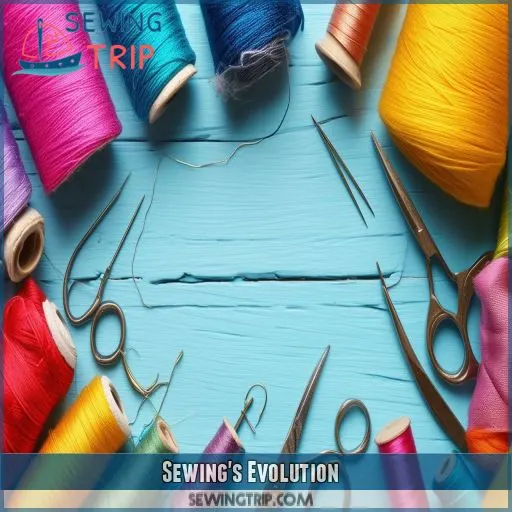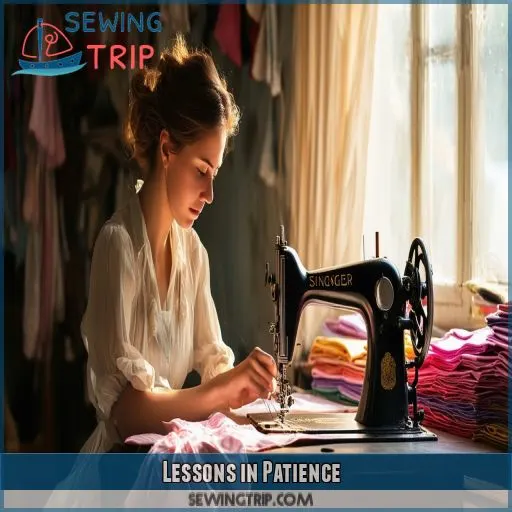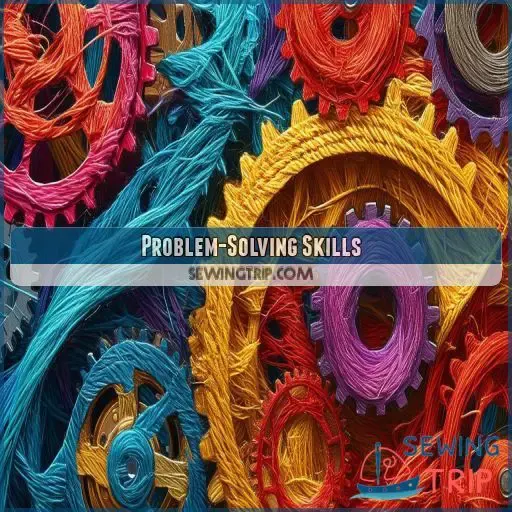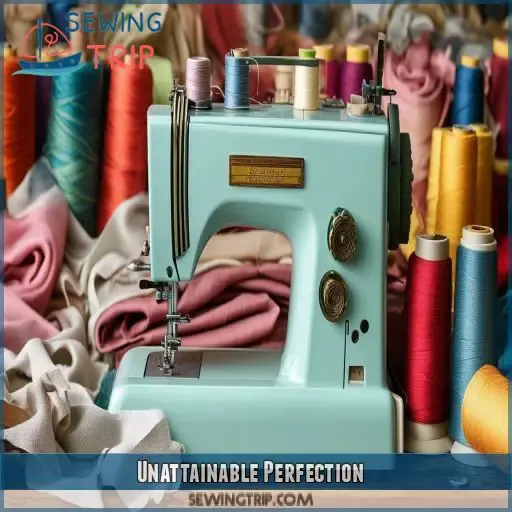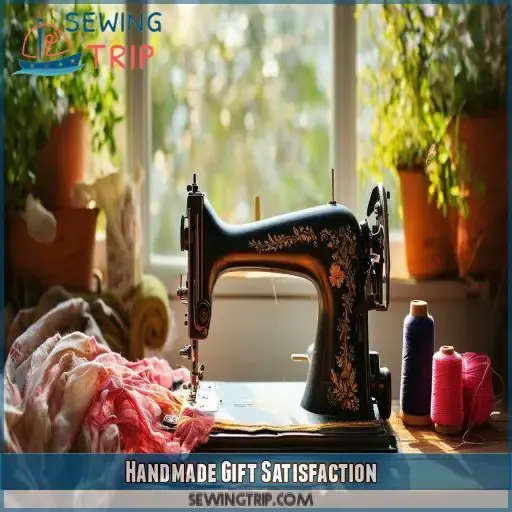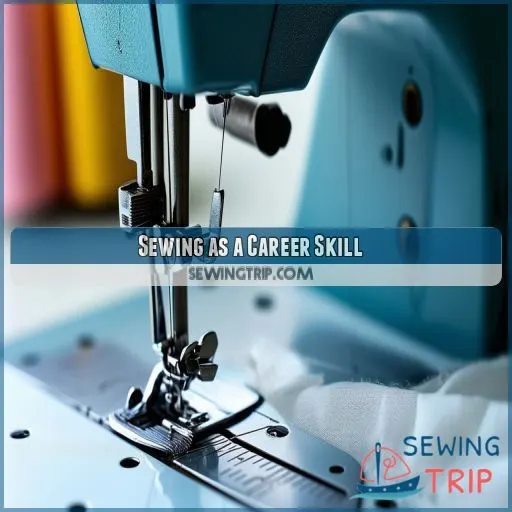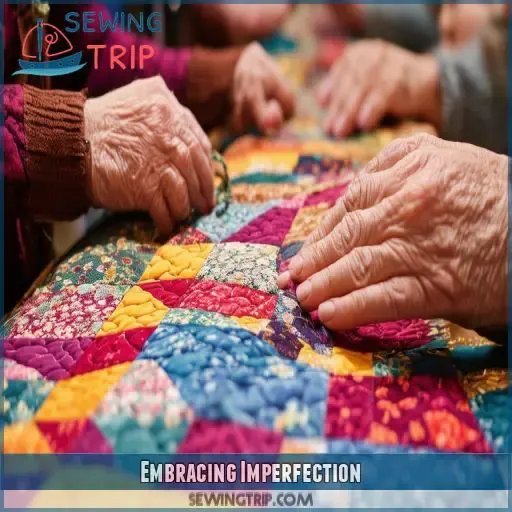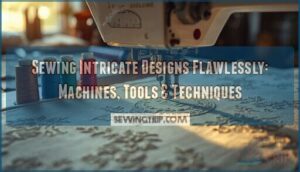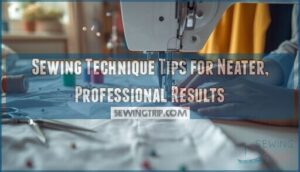This site is supported by our readers. We may earn a commission, at no cost to you, if you purchase through links.
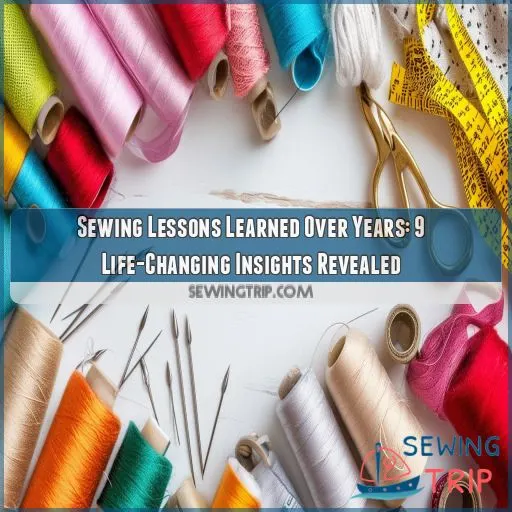
These nine points give insights into just how sitting at that sewing machine shaped you—from patient making to embracing imperfection.
You shall find this craft, the one passed across generations, has grown to be so much more today—a strong tool for personal growth, creative expression, and generational connections.
Unravel the threads of experience and unleash this power of transformation, hidden in every seam.
Table Of Contents
Key Takeaways
- Patience isn’t just a virtue, it’s your secret weapon. From battling stubborn zippers to unpicking wonky seams, sewing teaches you to take a deep breath and keep on stitching. Remember, Rome wasn’t built in a day, and neither was that perfect party dress!
- Embrace the happy accidents. That slightly crooked hem? It’s not a flaw, it’s a feature! Perfection is overrated, and your handmade creations are all the more charming for their quirks. Think of it as giving your clothes personality, one misaligned pattern at a time.
- Sewing is more than just a hobby – it’s a life skill that can open doors. Whether you’re whipping up custom creations for profit or mending clothes to save a pretty penny, those nimble fingers of yours are worth their weight in gold thread.
- Thread by thread, you’re stitching together a tapestry of connections. From swapping tips at the local sewing circle to passing down techniques to the next generation, your needle and thread are weaving you into a rich fabric of community and family history. Who knew a simple bobbin could tie you to both past and future?
Sewing’s Evolution
You’ve witnessed sewing’s remarkable evolution over the years, from hand-stitching to high-tech machines. Sewing through time has shaped fashion and daily life. Historical sewing techniques, once passed down through generations, have merged with modern innovations. You’ll find that sewing’s influence on fashion has been profound, enabling rapid style changes and mass production.
Technological advancements in sewing have revolutionized the craft. From vintage sewing machines to computerized models, you’ve gained precision and efficiency. These changes have made complex projects more accessible, even for beginners.
Interestingly, sewing’s role in sustainability has come full circle. You’re now using age-old mending techniques to reduce waste, just as your ancestors did out of necessity. As you explore sewing lessons learned over years, you’ll discover a rich tapestry of skills and knowledge. This evolving craft continues to adapt, offering endless opportunities for creativity and personal growth in our fast-paced world.
Lessons in Patience
The deeper you get into sewing, the more you’ll come to realize that it isn’t just stitching fabric together. Rather, it’s a journey—teaching very valuable lessons in patience. There will be frustrating moments when the seams simply don’t seem to align or the zipper just refuses to work its way up. But don’t give up! These challenges are actually your best teachers.
What becomes very important is how one manages their time, working between sewing projects and daily life. Having realistic goals keeps you rubbing along when things seem rather slow. Keep in mind that every stitch means a step forward.
Mistakes? Not setbacks, but stepping stones. Every unpicked seam or wonky hemline is a chance to practice persistence. You’ll learn to embrace these "happy accidents" as part of your sewing journey.
As you get more practice, you’ll realize that patience isn’t necessarily about waiting but about holding on. Take that thin thread and just keep going and going. There’s a masterpiece waiting!
Problem-Solving Skills
More patience means that sewing is going to test your mind. Every project becomes a puzzle, and each is going to exercise your problem-solving prowess: tricky pattern instructions, recalcitrant fabric, or the stubborn sewing machine. Don’t sweat; these are opportunities for growth.
You will learn how to analyze a problem step by step and take each situation practively. Lateral thinking becomes very intuitive, innovating solutions, so when you can’t find the right zipper, you move on to reuse buttons or create a unique closure. Pattern drafting exercises your analytical muscles in the ability to turn 2D shapes into 3D garments.
Your sewing toolkit just expanded; it now contains needles, threads, and a sharp mind. These problematic skills you’ll apply to other areas of your life, attacking obstacles with newfound confidence. What you must remember is that every single stitch taken brings you one step closer towards mastery, so each solution for the problems you encounter is a victory in your sewing journey.
Unattainable Perfection
You’ll quickly realize that perfection in sewing is like chasing a mirage. It’s always just out of reach, teasing you with its illusion. But here’s the kicker: that’s exactly how it should be. As you tackle small projects or join challenges like Me-Made-May, you’ll learn to embrace your flaws and focus on progress instead. Each stitch, whether perfect or not, is a step forward.
Remember those public domain sewing books? They’re full of wisdom about acceptance and improvement. They’ll teach you that mistakes aren’t setbacks; they’re opportunities to grow. So, when you stumble upon those irresistible fabric sales, don’t shy away from challenging yourself.
The real magic happens when you stop aiming for flawless and start celebrating your journey. Your handmade items might’ve quirks, but that’s what makes them uniquely yours. Embrace the imperfections, and you’ll find liberation in the process.
Creative Freedom
You’ll find true joy in sewing when you embrace creative freedom. It’s time to break free from rigid rules and explore your unique vision. Don’t be afraid to experiment with unconventional fabrics or create your own finishes. Try pairing unlikely patterns or adding unexpected embellishments. Your dress form becomes a canvas for innovation, not just a tool for fit.
Break the rules! Use luxurious silk for everyday wear or mix prints that shouldn’t work but somehow do. Create your own techniques through trial and error. You might stumble upon a revolutionary way to use pin cushions or discover a fabric combination that becomes your signature style.
Handmade Gift Satisfaction
You’ll find another reward besides creative freedom in sewing: the enjoyment of making handmade gifts. It means something very special when people can make things for others with personal input of time and gifted expertise. With a handmade present, you don’t give something— rather a part of you goes with the gift.
It is an emotional attachment that, in some ways, nobody could break. Be it a quilt to keep a new baby warm or a shirt made to measure for your close person, the weight your presents convey by being handmade is beyond measure. They get treasured as keepsakes, imbued with your care and attention.
When you can create something that’s just right, special occasion gifting takes on new meaning. You’ll feel that deep love with every stitch, working into every piece of fabric for this human being. The more confident you become with your sewing skills, the more ways you’ll find to show your appreciation and love with your craft.
Sewing as a Career Skill
You’ve discovered the joy of creating handmade gifts; now, let’s explore how sewing can become more than just a hobby. Sewing as a business is a viable career path that can provide a steady income. Whether you’re crafting custom pieces or mending clothes, there’s a market for your skills.
To turn sewing into a profession, start by honing your techniques and building a portfolio. Consider specializing in a niche, like bridal wear or costume design, to set yourself apart.
As you grow your sewing-for-profit venture, invest in quality equipment and learn to price your work fairly. Remember, running a sewing business isn’t just about stitching; it involves marketing, customer service, and time management.
With dedication and smart planning, you can transform your passion into a thriving trade. The best part? You’ll be doing what you love while earning a living.
Community & Generational Connection
Indeed, sewing is more of a life skill that helps to engage the tapestry of relationships entwined through ages and different communities. You’ll come to find out that picking up a needle and thread simply engages you in intergenerational mentoring and family bonding. These community workshops will become hubs of shared knowledge, as the experienced sewers pass on their wisdom to the eager learners.
This is where sewing also makes people appreciate community and cross-generational connections:
- Join clubs of sewists SHARE tips and tricks
- Participate in quilting bees to create collaborative works of art
- Teach the child some basic techniques of stitching—to develop patience and creativity centerY.
- Organising swap events with a "mend and make do" theme
You aren’t making clothes, but you’re sewing the texture of your community in these activities. In sharing techniques and stories, you’re then significantly contributing to the larger context of heritage preservation. Each project becomes another thread in the great tapestry of your family’s history, connected through the annals of human time to those who came before, and to those who’ll follow after. The activities become a work that surpasses time and binds one life with another.
Embracing Imperfection
As you connect with fellow sewers across generations, you’ll come to realize that perfection is an elusive goal. Embracing imperfection is the next step in your sewing journey. You’ll learn to see the beauty in those slightly crooked stitches or mismatched patterns. These "flaws" aren’t failures; they’re the charm that makes your creations uniquely yours.
Embrace the authenticity of handmade items. They tell a story, carry your energy, and showcase your progress. As you continue to sew, you’ll find that it’s not about achieving flawless results, but about the joy of creation and self-expression. So go ahead, wear your "imperfect" creations with pride!
Frequently Asked Questions (FAQs)
How has sewing changed over time?
You’ve seen sewing evolve from hand-stitching to electric machines. Now, there’s computerized embroidery and smart fabrics. Techniques have simplified, patterns are digital, and sustainability’s a focus. You’re part of a craft that’s constantly reinventing itself.
What has sewing taught you?
You’ve learned patience and precision through sewing. It’s taught you to embrace imperfections, solve problems creatively, and express yourself. You’ve discovered the joy of creating something unique, while developing a skill that connects you to others.
What skills do you develop from sewing?
You’ll develop patience, precision, and problem-solving skills. Sewing sharpens your eye for detail, boosts creativity, and enhances spatial awareness. You’ll gain dexterity, learn to follow instructions, and cultivate perseverance as you tackle increasingly complex projects.
How many years does it take to learn sewing?
You’ll develop basic sewing skills in a few months, but mastery takes years. It’s a journey of continuous learning. You’ll improve with each project, honing your craft over time. There’s always something new to discover!
How do I choose the right needle for different fabrics?
You’ll need to match your needle to your fabric’s weight and type. Choose fine needles for delicate fabrics, heavier ones for denim or canvas. Universal needles work for most projects, but specialty needles can make tricky fabrics a breeze.
What are the best techniques for sewing stretch materials?
Like taming a wild beast, sewing stretch fabrics requires finesse. Use a ballpoint needle, zigzag stitch, and walking foot. Don’t stretch the fabric while sewing. Test on scraps first. Adjust tension and stitch length as needed.
How can I effectively match patterns when sewing seams?
To match patterns when sewing seams, you’ll need precision and patience. Pin your fabric carefully, aligning the pattern at key points. Cut accurately and use a walking foot on your machine. Don’t rush; take your time for perfect results.
Whats the proper way to finish raw edges?
You’ve been wondering about those pesky raw edges, haven’t you? Here’s the secret: zigzag stitch, pinking shears, or serging are your go-to methods. For a polished look, try French seams or bias binding. It’s easier than you think!
How do I adjust patterns for a better fit?
To adjust patterns for a better fit, you’ll need to measure yourself accurately and compare those measurements to the pattern. Make necessary alterations, like lengthening or shortening, adjusting darts, or modifying seams. Always create a muslin first to test changes.
Conclusion
Stitch by stitch, sewing lessons learned over years weave a tapestry of life skills. You’ve mastered patience, problem-solving, and the art of imperfection.
Your creativity has flourished, and you’ve crafted meaningful connections across generations. Whether you’re mending clothes or stitching together a career, sewing’s impact extends far beyond the fabric.
Embrace the journey from novice to skilled seamstress, and let each project be a reminder of your growth. The wisdom gained through sewing will continue to shape your life, one thread at a time.

